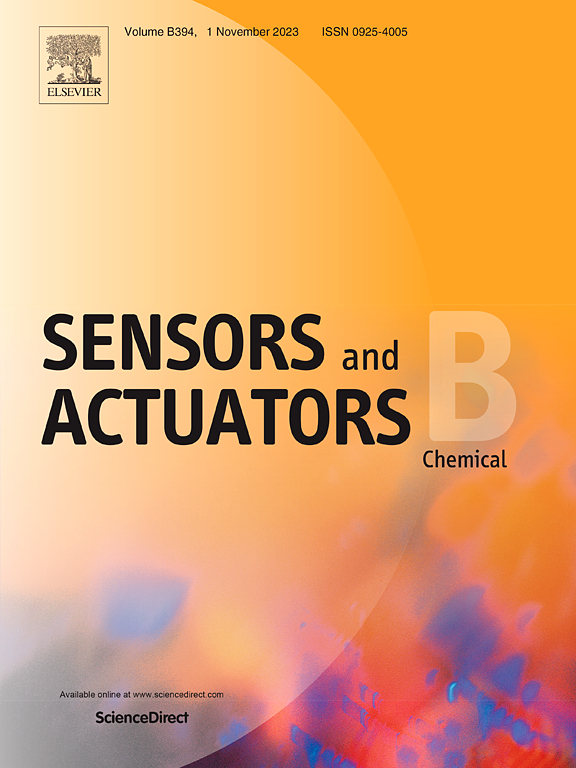制备线粒体黏度激活荧光探针,用于体内肾损伤的高灵敏度成像
IF 8
1区 化学
Q1 CHEMISTRY, ANALYTICAL
引用次数: 0
摘要
糖尿病性肾损伤已成为肾脏疾病的重要病因之一。早期发现和干预可以有效延缓肾脏疾病的发展。黏度作为细胞微环境的关键参数,在维持线粒体功能和细胞内稳态中起着关键作用,其失调与糖尿病肾损伤的发病密切相关。然而,利用荧光探针测定糖尿病肾损伤过程中线粒体粘度变化的报道很少。本文采用“渐进式优化(PO)”策略,开发了一种基于半紫花碱的近红外(NIR)荧光探针P4,能够对肾细胞和体内线粒体粘度变化进行靶向成像。P4探针对黏度具有较高的灵敏度和选择性,在高黏度环境下信号增强约146倍,并呈线性关系(R2=0.995)。P4的荧光量子产率(Φ)从PBS(低粘度)中的<;0.001增加到90%甘油(高粘度)中的0.12。此外,P4探针显示出优异的线粒体定位效率,可以实时监测糖尿病肾损伤进展和治疗干预过程中线粒体粘度的变化。此外,P4探针在体内检测到糖尿病肾损伤模型的黏度变化,信号强度比健康对照组增加1.5倍。利用P4探针,我们首次在高糖肾细胞损伤模型中考虑了铁下垂相关的黏度变化。这项工作将为深入了解肾脏疾病的黏度变化提供有意义的工具,并有望促进肾脏疾病的早期诊断和治疗。本文章由计算机程序翻译,如有差异,请以英文原文为准。

Fabricating a mitochondrial viscosity-activated fluorescent probe for highly sensitive imaging of kidney injury in vivo
Diabetic kidney injury has become one of the considerable causes of kidney diseases. Early detection and intervention can effectively delay the development of kidney diseases. Viscosity, as a critical parameter of the cellular microenvironment, plays a pivotal role in maintaining mitochondrial function and cellular homeostasis, and its dysregulation is closely associated with the pathogenesis of diabetic kidney injury. However, it is rarely reported that fluorescent probes are used to determine mitochondria viscosity changes in the process of diabetic kidney injury. Herein, a hemicyanine-based near-infrared (NIR) fluorescent probe P4 was developed using a “progressive optimization (PO)” strategy, enabling targeted imaging of mitochondrial viscosity changes in kidney cells and in vivo. The P4 probe possessed high sensitivity and selectivity toward viscosity and exhibited an approximately 146-fold signal enhancement in high-viscosity environments with a linear relationship (R2=0.995). And the fluorescence quantum yield (Φ) of P4 increased from < 0.001 in PBS (low viscosity) to 0.12 in 90 % glycerol (high viscosity). Moreover, P4 probe showed excellent mitochondrial localization efficiency, enabling real-time monitoring of mitochondrial viscosity changes during diabetic kidney injury progression and therapeutic intervention. In addition, P4 probe detected viscosity variations with a 1.5-fold signal intensity increase in diabetic kidney injury models compared to healthy controls in vivo. Using P4 probe, the viscosity changes related to ferroptosis were also accounted in the high glucose-induced kidney cell injury model for the first time. This work would provide a meaningful tool for gaining deeper insight into the viscosity variations in the kidney diseases, and it is expected to promote early diagnosis and treatment of kidney diseases.
求助全文
通过发布文献求助,成功后即可免费获取论文全文。
去求助
来源期刊

Sensors and Actuators B: Chemical
工程技术-电化学
CiteScore
14.60
自引率
11.90%
发文量
1776
审稿时长
3.2 months
期刊介绍:
Sensors & Actuators, B: Chemical is an international journal focused on the research and development of chemical transducers. It covers chemical sensors and biosensors, chemical actuators, and analytical microsystems. The journal is interdisciplinary, aiming to publish original works showcasing substantial advancements beyond the current state of the art in these fields, with practical applicability to solving meaningful analytical problems. Review articles are accepted by invitation from an Editor of the journal.
 求助内容:
求助内容: 应助结果提醒方式:
应助结果提醒方式:


